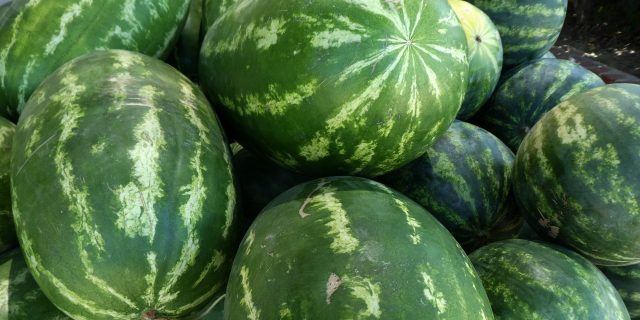23
Nov
Study Finds that Pollinators, Not Pesticides, Are More Important to Higher Crop Yields

(Beyond Pesticides, November 23, 2022) A new study throws into question the value of the pest management concept of setting action levels around pest infestations. In the course of watermelon production over a span of two years, pollination, not pest levels, was the key determining factor for yield. “These data advocate for a reprioritization of management, to conserve and protect wild bee pollination, which could be more critical than avoiding pest damage for ensuring high yields,” the study, published in Proceedings of the Royal Society B, indicates.
Action levels are considered an important aspect of an integrated pest management (IPM) approach in agriculture, whereby a pest infestation reaches levels considered economically unacceptable, leading to a decision to engage in pest control. The concept of IPM however has been influenced by the chemical industry over the decades since its original definition and recent data indicates that it has failed to stop toxic pesticide use. The original intent of IPM was the adoption of preventive practices and utilization of nonchemical tools, placing pesticide use as a last resort when pest control is warranted. However, farms that self-identify as IPM operations use pesticides, sometimes as the first line of defense, while attempting to “minimize” nontarget damage when applying a chemical. This continuing dependence on pesticides and synthetic fertilizers is disruptive of ecological balance, healthy soil biology, natural nutrient cycling, and the overall benefits are working with nature, now referred to as ecosystem services.
It is often said that IPM rejects the concept of “spraying by the calendar” or prophylactic use of pesticides. However, many so-called IPM operations, for example, use treated seeds, like those coated with neonicotinoid insecticides that contaminate pollen, nectar, and guttation droplets—a classic example of a prophylactic pesticide use before threshold pest populations are identified with devastating, indiscriminate poisoning effects to pollinators.
Beyond the choice of management approaches, the results of the study cast doubt on the importance of following action levels that establish thresholds of pest populations that trigger chemical use. To evaluate the interaction between pollination, pests, and crop yields, researchers set up field trials at a watermelon farm, observing the interaction between wild and managed honey bee pollination, striped cucumber beetles, and watermelon yields.
An initial field trial focused on the impact of varying pollination approaches on watermelon yield and fruit quality. It determined that honey bee pollination led to the lowest fruit set and weight, while open and wild bee pollination were significantly higher.
A second field trial applied striped cucumber beetles to rows of watermelon plants at varying densities – either zero, three, six, or nine beetles per plant. Rows were subsequently covered for a total of three weeks. For each row, six plants were then assessed for their beetle damage. Additionally, researchers applied six different pollination treatments to each of the beetle infested rows, including two honey bee visits, two wild bee visits, four honey bee visits, four wild bee visits, open pollination and hand pollination.
Researchers found that watermelon damage corresponded with pest density. For example, the highest beetle density had 50% smaller roots than the beetle-free control group. However, beetle damage had no effect on yield. Based on statistical analysis, the most important factor for watermelon yield was pollinator visitation. In fact, fruit set resulting from wild bee visitation was found to increase yield by 1.5-3 times more than honey bee visitation. The same factors held true for the weight and quality of the watermelons produced in the trial.
The results are surprising since the striped cucumber beetle is considered a major pest of the watermelon. Widely accepted thresholds for beetles on watermelon crops are fewer than five beetles per plant, and many growers apply pesticides on a consistent basis to keep populations below two beetles per plant. The study indicates that these insecticide applications are likely doing more harm than good.
As the study finds, “This collective work, including the data reported here, strongly suggest that in watermelon, and potentially other pollinator-dependent crops, insecticide applications, counterintuitively, have a higher likelihood of reducing than increasing yields due to interference with bee foraging and the lack of threat posed by the pest community. Given this imbalance (i.e. pollinators outweigh pests), insecticide use decisions by growers should consider wild bee presence and activity to optimize yield, which is currently not common practice.”
When a broader view of the environment is considered, including the complex interactions between a range of pests, predators, and pollinators, often a different picture emerges that changes one’s outlook on how to best manage land. Beyond Pesticides has recently reported on similar issues with fungicides. A study last month found their use to be self-defeating and yield-jeopardizing by reducing the prevalence of beneficial arbuscular mycorrhizal fungi that help facilitate nutrient uptake. Earlier this week a study was published showing how fungicides fail to kill certain plant pathogenic fungi, which are able to subsequently multiply and thrive as a result of reduced competition.
We must work toward a holistic approach to farming and land management. Rather than attempt a one-size-fits-all, regimented approach to food production that simplifies nature through industrial processes, regenerative organic, and traditional farming practices embrace complex natural processes and aim to enhance existing ecological processes. Join Beyond Pesticides in urging aid programs support traditional and organic farming, rather than chemical-first approach that jeopardizes our health and biodiversity.
All unattributed positions and opinions in this piece are those of Beyond Pesticides.
Source: Proceedings of the Royal Society B










